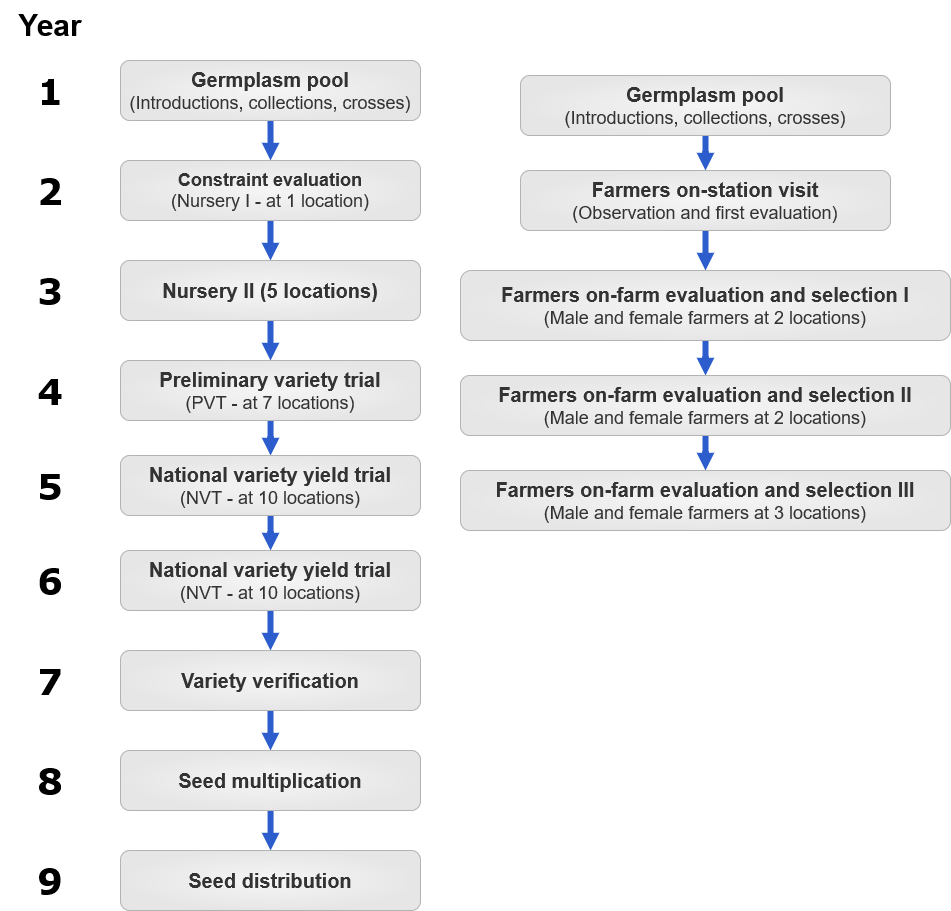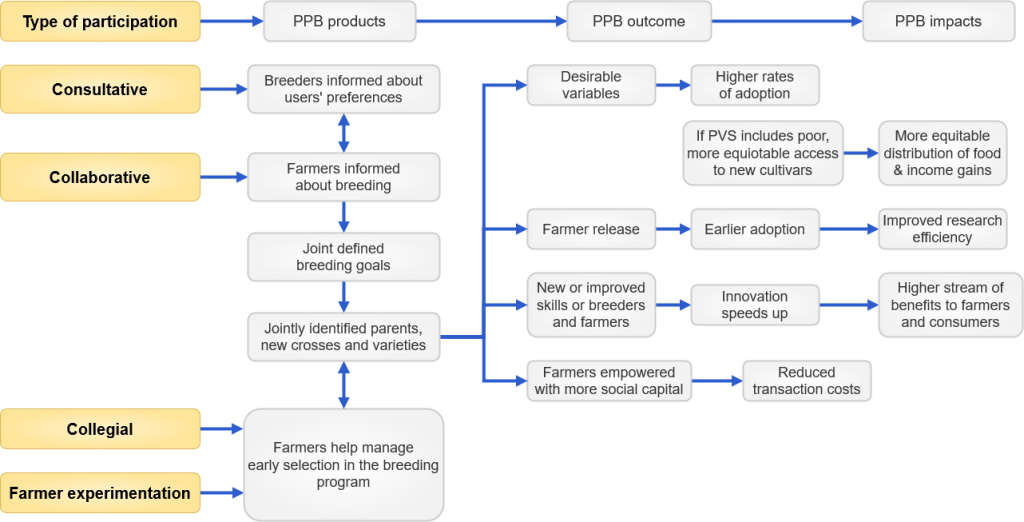Chapter 7: Participatory Plant Breeding and Participatory Variety Selection
Teshale Mamo; Asheesh Singh; Anthony A. Mahama; and Walter Suza
Formal or conventional plant breeding programs (centralized breeding programs) are often designed to meet specific requirements of different groups of farmers in different growing environments (regions, countries, soil, or climatic conditions). Formal or conventional plant breeding programs have generally been more beneficial to those farmers who either have good crop growing environments or have the capacity to modify growing environments through the application of additional inputs such as fertilizer, pesticides, and irrigation to create more favorable growing conditions for new varieties. However, the results of formal plant breeding may sometimes not meet the requirements of those farmers who grow their crops under marginal soils and high-stress environmental conditions (Sperling et al., 2001) thus necessitating different breeding approaches to be created to meet the needs of poor farmers.
Participatory plant breeding (PPB) and participatory variety selection (PVS) have been developed and implemented over the past 10 years as an alternative and integral part of the breeding approach in traditional plant breeding. It has been mainly implemented in developing countries where farmers with limited resources grow their crops in marginal lands of remote regions. It is practically implemented in areas where the technology transfer or adoption of modern cultivars is low (as farmers are not comfortable with taking the risk to replace their well-known and reliable traditional varieties with new varieties) or where modern cultivars are not available. Therefore PPB has emerged to address the agricultural problems of poor farmers in developing countries where resources and modern technologies are limited. PPB has been widely considered to be more advantageous to use in areas where low yield potential, high stress (drought), and heterogeneous environments exist. The various aspects of PPB described above are depicted in Fig. 1 below.
- Know the goals of participatory plant breeding
- State the different types, stages, and requirements of participatory plant breeding
- Describe the roles farmers play in participatory plant breeding
- Articulate the outcomes and impact of participatory plant breeding and participatory variety selection

Participatory Plant Breeding (PPB)
PPB Categories
It is an approach involving different participants including scientists, farmers, along with consumers, extension agents, farmers’ cooperatives, vendors, traders, processors, government and non-government organizations in plant breeding research (Sperling et al., 2001). It is considered as “participatory” because of the mixture of different people from different organizations involved, especially end-users, having significant research roles in all major stages of the breeding, evaluation and selection process. These different actors participate in setting PPB goals, setting breeding priorities, selecting genotypes from a heterogeneous population, helping in evaluation and selection of cultivars in the farmers’ fields and on research stations, releasing and popularizing high yielding cultivars, and helping in seed multiplication and distributing (McGuire et al., 2003). Participatory plant breeding is grouped into the following categories:
- Formal-led Participatory Plant Breeding describes a situation when farmers are asked to join in PPB activities which have been initiated, managed and executed by formal breeding programs such as National Agricultural Research System (NARS) or International Agricultural Research Center (IARC).
- Farmer-led Participatory Plant Breeding describes a situation when scientists and/or development workers seek to contribute or support famers own controlled, managed and executed breeding systems. Scientists can support their own varietal selection and seed system.
Goals of PPB
In any PPB approach, the first activity involves carrying out a diagnostic survey. The diagnostic survey allows an effective discussion between breeders and farmers and also enables breeders to better understand:
- agricultural problems of the local farming conditions,
- farmers’ crop management practices,
- farmers’ specific needs and preferences.
The goals of PPB are to:
- Increase production and productivity in non-commercial crops in environments that are unpredictable and under abiotic and/or biotic stress.
- Enhance biodiversity and increase germplasm access to local farmers. This provides benefit to local farmers, especially to disadvantaged user groups (women and poor farmers), for developing adapted genotypes. It also makes the breeding program cost-effective and output-oriented through decentralization that can address more niches.
- Increase farmer skills to speed up farmer selection and seed production efforts.
Types of Participation
The types of participation in PPB are:
- Conventional: In this approach, there is no farmer participation.
- Consultative: Farmers are consulted at every PPB stage but the breeder makes the decisions. The consultation of farmers starts from identifying breeding objectives and selection of appropriate parental materials. In this approach, farmers participate in making joint selections with a breeder among genotypes in breeders’ plots on station.
- Collaborative: In this approach, decisions are made jointly by farmer and breeder. Farmers and breeders know each other regarding selection criteria and their priorities for their research through two-way communication. To revoke or override the joint decision made earlier, both farmer and breeder need to agree on the change(s). Usually this type of participation is effective for self-pollinated crops.
- Collegial participation: Farmers grow genotypes in their farm fields and make their own plant or genotype selections. In this approach farmers can make decisions in a group or individually but in an organized communication with the breeder. In this approach farmers voluntarily supply some of the seeds of selected genotypes to the breeder for further evaluation and seed multiplication.
- Farmer experimentation: In this approach breeders do not participate in selection of genotypes or in any farmers’ research activities. Farmers make their own decision either in a group or as individuals on how to implement their research activities with new genotypes without organized communication with breeders.
Stages of Participation
In general, participation approaches to choose and implement depends on the resources availability and type of the crop which could be used in PPB.
Stages of Participation In PPB Process
- Set the breeding objectives/targets: Farmers’ participation in setting breeding objectives begins from the participatory rural appraisal.
- Generate (access) genetic variability from local landraces or using collections for testing with complementary characteristics.
- Determine the approach (consultative/collaborative). This depends on the availability of resources and on the type of the crop (it is more easily done for collaborative participation if the crop is self-pollinated species) and selecting among segregating populations.
- Evaluate cultivar and discard inferior genotypes (culling) (this is participatory variety selection if the farmer is involved in selection of genotype).
- Collaborating with seed system (cultivar release, popularization, diffusion and seed multiplication and finally distribution).
Essential Requirements for Success
For PPB to be successful, the following requirements must be met:
- The local farmers should be interested in active participation during plant breeding/ selection process
- Breeders and farmers have to collaborate with each other during each stage of PPB
- Importantly, PPB has a better chance of success if:
- locally adapted parents are used in the development of crosses made for PPB
- selection of desirable or superior genotypes is made in the local environments
- cultivars that are selected by farmers should have traits important to the farmers
Roles And Contributions of Farmers in PPB Work
Farmers:
- provide technical leadership role in testing cultivars to specific environmental niches. They also contribute their knowledge and experiences.
- play a role in organizing farmer research groups.
- provide information on cultivar preferences and important traits that could be maintained or introduced to the existing land races.
- are involved in skill building through farmer-farmer interactions.
- provide their landraces or their genetic materials that could be used for further breeding work.
- provide land for testing the PPB genotypes.
Major Possible Outcomes
- Production gain: significant production gains would be expected through increased yield, increased stability of crop yield, faster uptake of released cultivars, wider diffusion of the varieties and better identification of farmer-preferred quality traits (e.g. taste, ease of processing, etc.).
- Biodiversity enhancement: Farmers communities get more access to different germplasm, more information related to germplasm as well as getting related knowledge, increases access to inter and intra cultivar diversity.
- Cost-efficiency and cost effectiveness: The time of selection is short so cultivars are identified within shorter timeframe (3-4 years), i.e. cultivars identified faster. This reduces research cost. The released cultivars do not take a long time to disseminate to the farmers so less expensive for diffusing cultivars. Figure 2 is a timeline comparing conventional and PPB systems in bean breeding and clearly shows the fewer number of years involved in selection for the next cycle or variety release with PPB system.
- Farmer knowledge increase and capacity is enhancement: this facilitates the development of more PPB lines, gain in extensive experience and increase in agricultural knowledge dissemination, including agronomic practices.
- Farmers’ needs are met. Farmer satisfaction increases due to fulfillment of their demand. A broader range of users, such as women, men, elders and young, is reached.
Impacts of PPB
- Higher adoption rate of PPB products such as new cultivars, agronomic and crop protection practices.
- Improved cultivars acceptable by farmers for highly stressed marginal areas.
- In most remote areas of developing countries where soil is degraded and drought is a major production problem, new varieties developed and immediate adoption of the new technologies and yield increase is achieved.
- Significant changes in cultivar release procedure and seed multiplication system. In PPB, time for testing to release of cultivar is shorter than conventional breeding.
Participatory Variety Selection (PVS)
Introduction
Generally, participatory variety selection (PVS) is a continuation of PPB. Once potential cultivars are identified through PPB process, farmers can test those cultivars using PVS approach. Usually farmers participate at the end of the cyclical process.
More specifically, PVS is an approach where selection of finished or near finished cultivars is made by the farmer on her/his own fields. The finished products/genotypes include released cultivars, advanced stage cultivars, advanced non-segregating lines in self-pollinated crops or advanced populations in cross pollinated crops.
PVS includes research and extension methods that help to deploy genotypes (promising advanced lines/released cultivars) on farmers’ fields. Therefore, cultivars that are developed through PVS, would meet the demand of different farmers (men and women, old and young).
Participatory variety selection comprises three phases to select farmer preferred cultivars.
- Clear identification of farmers’ needs.
- Search for suitable advanced lines or cultivars to test in farmers’ conditions.
- Implementing the experiment on farmers own fields and dissemination of preferred cultivars.
Importance of PVS
- Provide access to local farmers’ choice of a large number of cultivars and increase in crop diversity.
- Increase production and productivity which helps to ensure food security.
- It helps to speed up dissemination and enhances adoption of pre-released and released cultivars in diversified environments.
- It enables cultivar selection in targeted environmental niches in a short period of time with less cost.
Conventional and Participatory Timeline
In Fig. 2, conventional and participatory breeding methods are shown, comparing the steps and duration for cultivar release, using beans as an example.

Impact Pathway
The impacts of participatory breeding are shown in Fig. 3 below.

References
Ashby, J. A. 2009. The impact of participatory plant breeding pp. 649-671. In: S. Ceccarelli, E. P. Guimaraes, and E. Weltzien, editor. Plant breeding and farmer participation. Food and Agriculture Organization of the United Nations, Rome, 2009.
Assefa, T., A. Girma, F. Chemeda, T. Bulti, and R. Abdel. 2005. Participatory bean breeding with women and smallholder farmers in eastern Ethiopia. World Journal of Agricultural Sciences 1 (1): 28-35, 2005.
McGuire, S. J. 2003. Path-dependency in plant breeding: Challenges facing participatory reforms in the Ethiopian Sorghum Improvement Program. Agricultural Systems 96 (2008) 139-149. ScienceDirect
Sperling, L., J. A. Ashby, M. E. Smith, E. Weltzien, and S. McGuire. 2001. A framework for analyzing participatory plant breeding approaches and results. Euphytica 122: 439-450.

